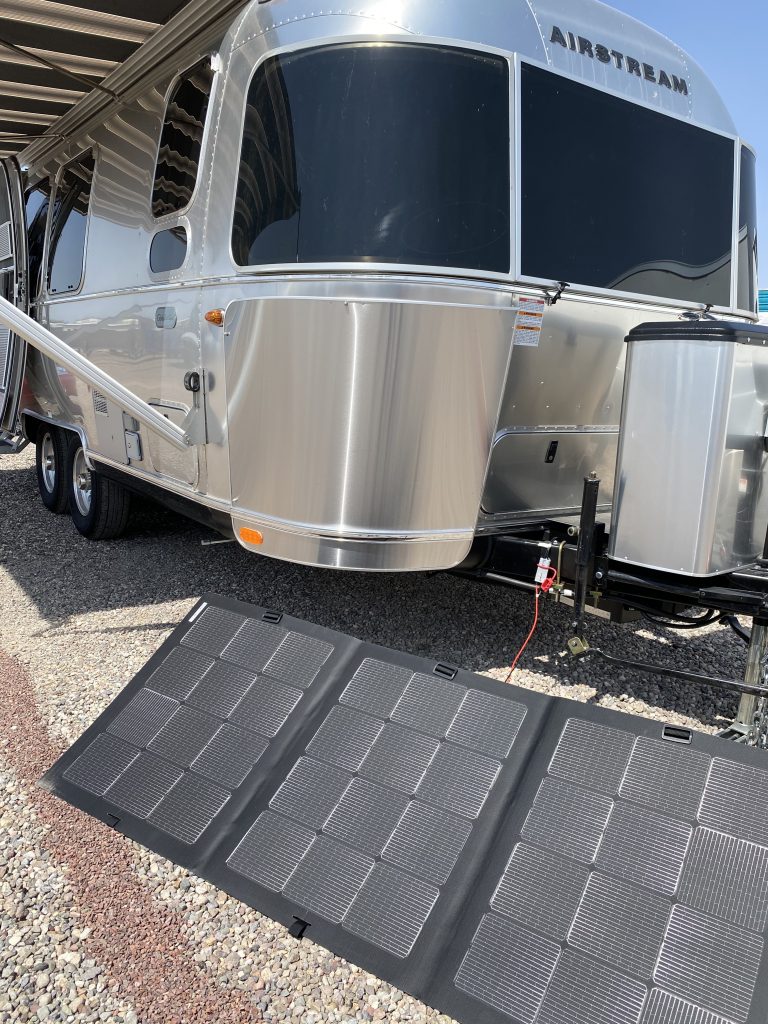Solar power is one of the most confusing topics for RV travelers in general, and it really shouldn’t be. It’s simple technology that adds free power to your Airstream’s batteries and it just works. For most people, it’s the obvious choice for extending their off-grid camping time.
The big advantage of using solar power is that once you install the hardware, there’s no ongoing cost or maintenance. When the sun shines, power flows into the batteries. You don’t have to flick a switch or remember to do anything. The system turns on automatically when the sun comes up, and it goes off when the sun goes down or the batteries are full.
Since solar is also silent, it’s great if you like to camp in quiet settings and don’t want to hear a generator running for hours. And it does a better job of charging batteries than a generator.
If you’re thinking solar is for you, your next choice is whether to install fixed solar panels on the roof or get portable solar panels that you can deploy on the ground. Let’s look at the advantages and disadvantages of each:
FIXED (ROOFTOP) SOLAR
- Complex and expensive installation, usually done professionally
- Holes drilled in your Airstream
- Bigger theoretical capacity usually compared to portable panels (200-400 watts depending on rooftop area)
- Permanently set up
- Power collection happens anytime, even when towing or in storage
- Won’t collect power if the trailer is parked in shade
- Panels can’t be oriented to the sun
PORTABLE SOLAR
- No installation required, just plug and play.
- No holes drilled in the Airstream
- Typically less capacity than rooftop solar (120-200 watts)
- Some setup required (a couple of minutes)
- Can’t leave it set up while in storage or when towing
- Can collect power when the Airstream is in shade
- Panels can be easily oriented to the sun to optimize effectiveness
(Sometimes people ask if they can have both rooftop solar and portable solar. With our system, yes you can, and both the rooftop and portable panels will contribute power to the batteries when the batteries need a lot of charge and the sun is shining.)
When people install rooftop solar on an Airstream they usually go big, putting up as many panels as will fit on the roof. This helps compensate for the fact that the panels are fixed in position (facing straight up) and can’t point at the sun when it is rising or setting. But in this case you’re paying for a fairly expensive solar array that isn’t producing as well as it could.
That’s exactly why our Portable Solar Kit can perform as well as a much bigger rooftop system. The lightweight panels can be pointed directly at the sun no matter where it is—down low on the horizon, or hidden behind trees—because you can tilt, orient, and move the panels to be where the sun is.
 In addition, our Portable Solar Kit uses a very high quality Merlin panel that has thousands of “interconnects” in each panel, many more than traditional panels. That means the panels are less affected by a bit of shading, say, from a leaf. The net result of this and the ability to move the panels to point at the sun means the 160-watt Portable Solar Kit can yield as much power as a significantly larger rooftop array.
In addition, our Portable Solar Kit uses a very high quality Merlin panel that has thousands of “interconnects” in each panel, many more than traditional panels. That means the panels are less affected by a bit of shading, say, from a leaf. The net result of this and the ability to move the panels to point at the sun means the 160-watt Portable Solar Kit can yield as much power as a significantly larger rooftop array.
Bottom line
If you don’t want to have to deploy a portable array each time you need it, or you need your solar panels to be producing all the time, rooftop solar may be for you. If you want the maximum power for your buck, maximum flexibility, and only need solar occasionally, portable solar will probably work better and save you money.

 But the limitation of a meter is that it can’t help you if there’s a power surge or dip when you’re not watching. The best solution is a smart Electrical Management System (EMS). Like the Voltage Meter, the EMS checks the wiring
But the limitation of a meter is that it can’t help you if there’s a power surge or dip when you’re not watching. The best solution is a smart Electrical Management System (EMS). Like the Voltage Meter, the EMS checks the wiring 
